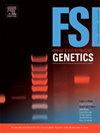一个样本,三种基因型:D19S433基因座的侧翼区域缺失导致CE和NGS技术之间的基因型差异
IF 3.1
2区 医学
Q2 GENETICS & HEREDITY
引用次数: 0
摘要
短串联重复序列(STRs)在法医遗传学中广泛应用于个体鉴定。传统的STR分析依赖于毛细管电泳(CE),而下一代测序(NGS)具有全等位基因序列分辨率、灵敏度和鉴别能力提高等优势。然而,侧翼区域的遗传变异可能导致CE和NGS方法之间以及不同分析软件之间的基因分型结果不一致。在GEDNAP水平测试65中,在D19S433位点观察到基因分型差异。使用MiSeq FGx®测序系统上的ForenSeq®DNA签名准备试剂盒对样品进行分析,使用ForenSeq™通用分析软件分析时得到基因型为11.2,16。这一结果与GEDNAP基于ce的结果报道的11.16基因型不同。来自ForenSeq的测序数据进一步用STRait Razor Online和STRNaming重新分析,得到基因型11.1,16。另外用三种不同的CE试剂盒(AmpFLSTR™Identifiler™Plus, NGM SElect™和GlobalFiler™)进行检测,产生16,16基因型,导致同一样品的三种不同的基因型分配。D19S433的5 '侧区有一个3 bp的TCT缺失,位于国际法医遗传学学会(ISFG)最小报告范围内,被认为是导致这些基因分型不一致的原因。PacBio Sequel II技术的长读测序证实,在引物结合区没有额外的变异存在,表明TCT缺失是导致差异的唯一原因。本研究强调了侧翼区域突变对不同STR分型技术中等位基因调用的影响,以及生物信息学管道中序列分析缺乏共识,强调需要将ISFG最小范围纳入NGS试剂盒测序和报告的区域,以确保实验室间和试剂盒间的一致性,最终最大限度地减少法医STR分型的差异。本文章由计算机程序翻译,如有差异,请以英文原文为准。
One sample, three genotypes: A flanking region deletion at the D19S433 locus causes genotyping discrepancies between CE and NGS technologies
Short tandem repeats (STRs) are widely used in forensic genetics for individual identification. While traditional STR analysis relies on capillary electrophoresis (CE), next-generation sequencing (NGS) offers advantages such as full allelic sequence resolution, improving sensitivity and discrimination power. However, genetic variations in flanking regions can lead to discordant genotyping results between CE and NGS approaches, as well as among different analysis software. During the GEDNAP Proficiency Test 65, a genotyping discrepancy was observed at the D19S433 locus. The sample was analyzed using the ForenSeq® DNA Signature Prep Kit on the MiSeq FGx® Sequencing System, yielding a genotype 11.2,16 when analyzed with the ForenSeq™ Universal Analysis Software. This result differed from the 11.1,16 genotype reported by GEDNAP’s CE-based results. Sequencing data from ForenSeq was further reanalyzed with STRait Razor Online and STRNaming, resulting in a genotype 11.1,16. Additional testing with three different CE kits (AmpFLSTR™ Identifiler™ Plus, NGM SElect™, and GlobalFiler™) produced a 16,16 genotype, leading to three different genotype assignments for the same sample. A 3-bp TCT deletion in the 5’ flanking region of D19S433, located within the International Society for Forensic Genetics (ISFG) minimum reporting range was identified as the cause of these genotyping inconsistencies. Long-read sequencing with PacBio Sequel II technology confirmed that no additional variants were present in the primer binding regions, demonstrating that the TCT deletion alone was responsible for the discrepancies. This study highlights the impact of flanking region mutations on allele calling across different STR typing technologies and the lack of consensus in sequence analysis among bioinformatics pipelines, emphasizing the need to incorporate the ISFG minimum range in the regions sequenced and reported by NGS kits to ensure inter-laboratory and inter-kit consistency, ultimately minimizing discrepancies in forensic STR typing.
求助全文
通过发布文献求助,成功后即可免费获取论文全文。
去求助
来源期刊
CiteScore
7.50
自引率
32.30%
发文量
132
审稿时长
11.3 weeks
期刊介绍:
Forensic Science International: Genetics is the premier journal in the field of Forensic Genetics. This branch of Forensic Science can be defined as the application of genetics to human and non-human material (in the sense of a science with the purpose of studying inherited characteristics for the analysis of inter- and intra-specific variations in populations) for the resolution of legal conflicts.
The scope of the journal includes:
Forensic applications of human polymorphism.
Testing of paternity and other family relationships, immigration cases, typing of biological stains and tissues from criminal casework, identification of human remains by DNA testing methodologies.
Description of human polymorphisms of forensic interest, with special interest in DNA polymorphisms.
Autosomal DNA polymorphisms, mini- and microsatellites (or short tandem repeats, STRs), single nucleotide polymorphisms (SNPs), X and Y chromosome polymorphisms, mtDNA polymorphisms, and any other type of DNA variation with potential forensic applications.
Non-human DNA polymorphisms for crime scene investigation.
Population genetics of human polymorphisms of forensic interest.
Population data, especially from DNA polymorphisms of interest for the solution of forensic problems.
DNA typing methodologies and strategies.
Biostatistical methods in forensic genetics.
Evaluation of DNA evidence in forensic problems (such as paternity or immigration cases, criminal casework, identification), classical and new statistical approaches.
Standards in forensic genetics.
Recommendations of regulatory bodies concerning methods, markers, interpretation or strategies or proposals for procedural or technical standards.
Quality control.
Quality control and quality assurance strategies, proficiency testing for DNA typing methodologies.
Criminal DNA databases.
Technical, legal and statistical issues.
General ethical and legal issues related to forensic genetics.

 求助内容:
求助内容: 应助结果提醒方式:
应助结果提醒方式:


